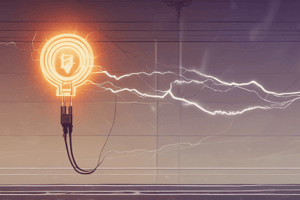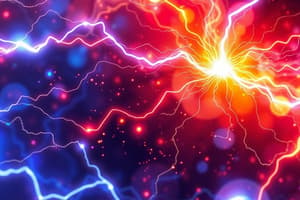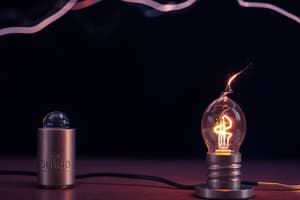Podcast
Questions and Answers
Which perspective refers to the flow of positive charge despite only electrons moving in reality?
Which perspective refers to the flow of positive charge despite only electrons moving in reality?
- Electron flow
- Alternating current
- Direct current
- Conventional current (correct)
What type of current is consistently unidirectional and commonly found in batteries and solar cells?
What type of current is consistently unidirectional and commonly found in batteries and solar cells?
- Ohm's Law
- Continuity principle
- Alternating current (AC)
- Direct current (DC) (correct)
What principle states that current stops if the closed circuit is broken?
What principle states that current stops if the closed circuit is broken?
- Continuity principle (correct)
- Ohm's Law
- Alternating current (AC)
- Direct current (DC)
Which law describes the relationship between current, voltage, and resistance?
Which law describes the relationship between current, voltage, and resistance?
In which type of current does the flow periodically reverse directions?
In which type of current does the flow periodically reverse directions?
What is electric current?
What is electric current?
Who pioneered the understanding of the relationship between voltage, current, and resistance in the late 19th century?
Who pioneered the understanding of the relationship between voltage, current, and resistance in the late 19th century?
In which direction do positive charges move in relation to electric current in a conductor?
In which direction do positive charges move in relation to electric current in a conductor?
What unit is used to measure electric current?
What unit is used to measure electric current?
If 4.2 x 10^(-7) moles of electrons pass through a wire every second, what is the current flowing through the wire?
If 4.2 x 10^(-7) moles of electrons pass through a wire every second, what is the current flowing through the wire?
Flashcards are hidden until you start studying
Study Notes
Electric Current
Electric current is a continuous flow of charged particles—usually electrons—through conductive materials such as metal wires. Understanding this fundamental concept is crucial when exploring the world of electricity. Let's dive deeper into the nature of electric current and its properties.
Historical Background
Thomas Alva Edison and others pioneered our understanding of the relationship between voltage, current, and resistance in the late 19th century, transforming these abstract concepts into practical applications like lighting up cities with electric power.
Flowing Charges
The direction of electric current indicates the movement of positive charges carried by the electrons through a conductor, from higher potential energy towards lower potential energy regions. In reality, it's the negatively charged electrons moving against their natural tendency (almost like swimming against a stream) due to the applied force of an external electric field.
Quantifying Current
We measure electric current using units called amperes (A), named after André Marie Ampère (1775–1836). One ampere equates to one coulomb of charge passing through a cross section per second. For example, if 6.28 x 10^(-7) moles of electrons pass through a wire every second, we say there is a current of 1 A flowing through the wire.
Conventional vs Electron Flow
When discussing electric current, you might encounter two different perspectives—conventional current and electron flow. Traditionally, current was considered the motion of positively charged particles, even though only electrons move in practice. However, modern convention still refers to conventional current, meaning the flow of positive charge, which correlates to actual electron movement being opposite.
Characteristics of Electric Current
Electric current exhibits several key characteristics:
- Direct current (DC): Consistent unidirectional current, used in batteries, solar cells, and electrical lights.
- Alternating current (AC): Periodically reversing current, used in transmission lines and consumer appliances worldwide.
- Continuity principle: To maintain current flow, a closed circuit must remain intact without breaks. If continuity ceases, current stops.
- Ohm's Law: Current depends directly upon the applied voltage and inversely upon the resistance.
Understanding the principles behind electric current lays the groundwork for comprehending more advanced components and systems involving electricity. Wielding this knowledge can help us appreciate how our daily lives benefit from the marvelous phenomenon of electric current.
Studying That Suits You
Use AI to generate personalized quizzes and flashcards to suit your learning preferences.




